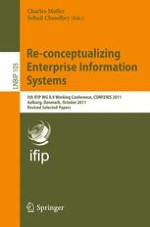This book constitutes the post conference proceedings of the 5th International IFIP Working Conference on Research and Practical Issues of Enterprise Information Systems (CONFENIS 2011), held in Aalborg, Denmark, October 16-18, 2011. The 12 papers presented in this volume were carefully reviewed and selected from 103 submissions. The papers are organized in four sections on conceptualizing enterprise information systems; emerging topics in enterprise information systems; enterprise information systems as a service; and new perspectives on enterprise information systems. These papers are complemented by two keynotes and a short summary of the co-located Workshop on Future Enterprise Information Systems using Lego Serious Games.
